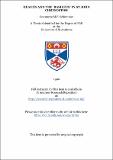Files in this item
Heaven and the 'basileus' in St John Chrysostom
Item metadata
| dc.contributor.advisor | Magdalino, Paul | |
| dc.contributor.author | Schummer, Constanze M. F. | |
| dc.coverage.spatial | 327 p. | en_US |
| dc.date.accessioned | 2018-06-05T14:31:02Z | |
| dc.date.available | 2018-06-05T14:31:02Z | |
| dc.date.issued | 1990-07 | |
| dc.identifier.uri | https://hdl.handle.net/10023/13735 | |
| dc.description.abstract | The thesis takes its inspiration from a parallel central to Byzantine ideology: God enthroned in heaven, governing the universe, is mirrored on earth by the emperor surrounded by his court, ruling his realm. The earliest definitive formulation of this doctrine is expressed by Eusebius of Caesarea in the 'Tricennial Orations' held for Constantine the Great in A.D. 336. The thesis briefly documents this formulation and then takes a look at the further evolution of this parallel in some fourth century Fathers. Here the parallel becomes a metaphor in that the earthly basileus is frequently employed to explain and describe God. At the same time, the attitudes towards the earthly basileus need not be positive. After having thus set the scene, the thesis moves on to its primary task and explores heaven and the basileus in St. John Chrysostom. The sheer bulk of his work is matched by the complexity of his views in this respect, far removed from the apparent simplicity of the Eusebian model. After documenting his ideas about the technique of metaphor, and about the application of such a parallel as that of God and basileus, I examine Chrysostom's metaphorical use of the basileus in his explanations of inexprimable divine qualities. The basileus takes more shape when Chrysostom describes him in the context of the Old Testament, of early imperial history, or as a contemporary ruler. These portrayals are suitably followed by an exploration of Chrysostom's uncompromising interpretation of the relationship between priest and ruler. A short excursus on his attitude towards imperial and Christian symbols rounds off this extensive treatment of the basileus. The next two chapters concentrate on how Chrysostom describes heaven and what role is played by imperial terminology and concepts in these descriptions. Finally, the possible influence of St. Paul on Chrysostom in these areas is considered - partly because the topos of the Apostle in the power of the pagan basileus Nero appears frequently, partly because St. Paul turns out to be a major Leitfigur for Chrysostom. This bulky documentation works exclusively from texts dating from Chrysostom's life in Antioch. His move to Constantinople and into the direct environment of the real basileus presents a chronological step of the utmost importance in the context of the God - basileus parallel. Introducing this chronological divide in the course of the thesis obviously involves a close attention to the dating of Chrysostom's works, which in many cases is not unequivocal. The thesis tries to show that the awareness of a chronology of metaphorical language within Chrysostom's works can help with the dating of individual texts. Although this possibility was resorted to very sparingly here for fear of introducing a circular argument, it merits becoming a stronger element in studies on Chrysostom. For the Constantinopolitan period, the thesis tries to ascertain whether Chrysostom's view of the earthly basileus and his use of metaphors based on this basileus in the description of heaven are influenced and changed by his experience of imperial reality. The most interesting question then is to what extent Chrysostom's metaphorical use of 'the basileus' in all its different shades of meaning precipitated his fate at imperial hands. As the conclusion argues, these findings are of special interest in view of the popularity Chrysostom enjoyed throughout Byzantine history. It is possible that with his extensive metaphorical use of the basileus he was a model and an influence in theological and ideological issues. There is the possibility that descriptions that were intended by Chrysostom to show the limitations of earthly rule in comparison with heavenly power may have been misunderstood, due to subtlety of expression, as describing a full parallel between God and basileus. This applies both to contemporary audiences and later readers and supports a hypothesis that Byzantine propaganda was not so much constructed by masterminds as inferred by audiences. | en_US |
| dc.language.iso | en | en_US |
| dc.publisher | University of St Andrews | |
| dc.subject.lcc | BR1702.C5S9 | en |
| dc.subject.lcsh | John, Chrysostom, Saint, d. 407 | en |
| dc.title | Heaven and the 'basileus' in St John Chrysostom | en_US |
| dc.type | Thesis | en_US |
| dc.type.qualificationlevel | Doctoral | en_US |
| dc.type.qualificationname | PhD Doctor of Philosophy | en_US |
| dc.publisher.institution | The University of St Andrews | en_US |
This item appears in the following Collection(s)
Items in the St Andrews Research Repository are protected by copyright, with all rights reserved, unless otherwise indicated.

